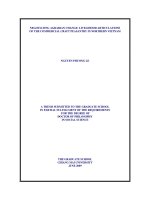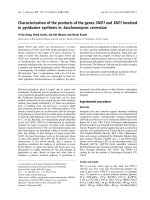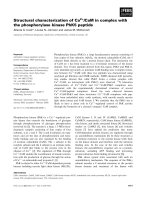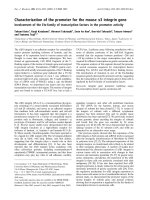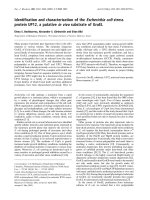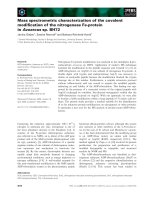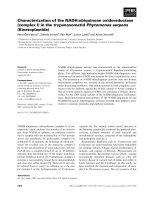Characterization of the bycatch in the commercial blue crab pot fishery in georgia, november 2003–december 2006
Bạn đang xem bản rút gọn của tài liệu. Xem và tải ngay bản đầy đủ của tài liệu tại đây (516.44 KB, 11 trang )
BioOne sees sustainable scholarly publishing as an inherently collaborative enterprise connecting authors, nonprofit publishers, academic institutions, research
libraries, and research funders in the common goal of maximizing access to critical research.
Characterization of the Bycatch in the Commercial Blue Crab Pot Fishery in
Georgia, November 2003–December 2006
Author(s): JamesWest Page Mary Carla Curran Patrick John Geer
Source: Marine and Coastal Fisheries: Dynamics, Management, and Ecosystem Science, 5():236-245.
2013.
Published By: American Fisheries Society
URL: />BioOne (www.bioone.org) is a nonprofit, online aggregation of core research in the biological, ecological, and
environmental sciences. BioOne provides a sustainable online platform for over 170 journals and books published
by nonprofit societies, associations, museums, institutions, and presses.
Your use of this PDF, the BioOne Web site, and all posted and associated content indicates your acceptance of
BioOne’s Terms of Use, available at www.bioone.org/page/terms_of_use.
Usage of BioOne content is strictly limited to personal, educational, and non-commercial use. Commercial inquiries
or rights and permissions requests should be directed to the individual publisher as copyright holder.
Marine and Coastal Fisheries: Dynamics, Management, and Ecosystem Science 5:236–245, 2013
C
American Fisheries Society 2013
ISSN: 1942-5120 online
DOI: 10.1080/19425120.2013.818084
ARTICLE
Characterization of the Bycatch in the Commercial Blue
Crab Pot Fishery in Georgia, November 2003–
December 2006
James West Page*
Georgia Department of Natural Resources, Coastal Resources Division, 1 Conservation Way, Brunswick,
Georgia 31520, USA
Mary Carla Curran
Department of Marine and Environmental Science, Savannah State University, Box 20600, Savannah,
Georgia 31404, USA
Patrick John Geer
Georgia Department of Natural Resources, Coastal Resources Division, 1 Conservation Way, Brunswick,
Georgia 31520, USA
Abstract
Bycatch studies have been conducted in many fisheries in Georgia, but none has focused on the commercial pot
fishery for blue crab Callinectes sapidus. The purpose of this study was to identify abundance and seasonality of
finfish and invertebrate bycatch species in the commercial blue crab fishery in Georgia. Between November 2003
and December 2006, observers accompanied volunteer commercial blue crab fishers randomly selected from a list of
willing participants. A total of 91 trips were observed, with 5,707 commercial blue crab pots sampled. Soak times,
or fishing effort, ranged from 24 to 168 h, averaging 55.8 h/trap for each trip. The number of traps sampled each
trip ranged from 5 to 163, with a mean of 62.7 traps per trip. We collected 306 finfish and 4,972 invertebrates in
this study period. The most numerous finfish were Southern Flounder Paralichthys lethostigma (n = 52), Atlantic
Spadefish Chaetodipterus faber (n = 50), Oyster Toadfish Opsanus tau (n = 50), Hardhead Catfish Ariopsis felis (n =
46), and Southern Kingfish Menticirrhus americanus (n = 37). The most numerous invertebrates species were hermit
crabs Pagurus spp. (n = 2,341), spider crabs Libinia spp. (n = 532), stone crabs Menippe mercenaria (n = 438),
channeled whelk Busycon canaliculatum (n = 1,570), and knobbed whelk Busycon carica (n = 25). The similarity of
bycatch by season was compared using a Morisita similarity index, and results were that Southern Flounder, Atlantic
Spadefish, Oyster Toadfish, spider crabs, channeled whelk, and stone crabs varied seasonally. Of all species observed,
we conclude that channeled whelk populations may be impacted by this fishery.
ThebluecrabCallinectes sapidus, a member of the Portu-
nidae family, is a common swimming crab commercially and
recreationally targeted in several states along the eastern U.S.
seaboard, including Georgia. A popular food item, the species is
often sold live to various restaurants, processing facilities, or in-
Subject editor: Donald Noakes, Thompson Rivers University, British Columbia, Canada
*Corresponding author:
Received October 22, 2012; accepted June 17, 2013
dividual consumers. Fishermen may employ any of several gear
types to harvest the species, though most commercial crabbers in
Georgia utilize pots to harvest blue crabs. While the number of
commercial crabbers in Georgia has declined in recent years (to-
taling < 150 annually), the blue crab fishery remains extremely
236
COMMERCIAL BLUE CRAB POT FISHERY BYCATCH 237
important, currently serving as Georgia’s largest commercial
fishery in terms of volume (kg) landed and second-largest
fishery in terms of economic value behind the penaeid food
shrimp fishery. In addition to catching blue crabs, crabbers have
reported capturing nontarget species in their pots, including
multiple whelk species, which may be retained for personal con-
sumption or offered for commercial sale. The reporting of these
nontargeted species, termed “bycatch,” has raised questions as
to what other bycatch species are encountered in blue crab pots.
Bycatch has been an issue of concern for many fisheries
throughout the world, including the southeastern USA (Rogers
et al. 1997; Crowder and Murawski 1998). Virtually all fisheries
conducted in the South Atlantic Bight produce unwanted catch
to some degree, and the volume and composition of bycatch
varies by fishery. The ecological and economic implications re-
sulting from such nontargeted catch also vary by fishery. The
ecological implications of harvesting bycatch include the po-
tential of negatively impacting finfish and invertebrate species,
some of which may be protected. The economic implications
of bycatch include increased expenses for adequate species pro-
tection, additional costs for modifying gear to reduce unwanted
catch, and lost fishing time sorting the catch.
Bycatch studies have been conducted in many fisheries
throughout the world, including those utilizing various nets
(trawl, gill, seine, etc.) and traps. For example, Favaro et al.
(2010) studied bycatch in the trap fishery for spot prawn Pan-
dalus platyceros in British Columbia. With regards to bycatch
studies in the southeastern USA, perhaps no other fishery has
been studied more than the commercial shrimp trawl fishery.
The effects and composition of bycatch from large shrimp trawls
have been studied in detail (Wallace and Robinson 1994; Ortiz
et al. 2000; Baum et al. 2003; Diamond 2003); alternatively, the
bycatch of the commercial blue crab pot fishery in Georgia has
not. While these two fisheries utilize different gears, the marine
waters in which they often fish share many of the same species.
Consequently, information on any targeted or incidental takes
of marine organisms by any of these gears is needed by fish-
ery managers overseeing the management of these populations.
Anecdotal information suggests that the bycatch in the com-
mercial blue crab pot fishery is minimal and consists primarily
of invertebrates, though characterization and quantification of
such bycatch has yet to be conducted. Work has been conducted
in multiple states, including Georgia, on the bycatch of dia-
mondback terrapins Malaclemys terrapin in commercial blue
crab traps, primarily through investigating gear modifications to
reduce their capture (Bishop 1983; Seigel and Gibbons 1995;
Guillory and Prejean 1998; Belcher and Sheirling 2004).
Seasonal residence time is a critical factor to consider when
determining the species composition of bycatch in a fishery.
Many marine species, such as migratory sharks, inhabit an area
only seasonally and are not available for harvest outside that mi-
gratory period (Carlson and Brusher 1999). Therefore, the im-
pact on these animals may be narrowed to a specific window of
time. Annual residence periods may be determined with the use
of long-term monthly surveys designed to examine species pres-
ence and abundance, such as the monthly trawl survey conducted
by the Georgia Department of Natural Resources (GADNR;
Page et al. 2004). Southern Flounder Paralichthys lethostigma
were observed in GADNR trawl data in each of the four sea-
sons, though Wenner and Archambault (2005) concluded that
seasonal movements for this species did occur and were directly
related to life stage. Southern Flounder occurred in nearshore
shallow coastal waters during warm months and migrated off-
shore in colder months. Oyster Toadfish Opsanus tau were also
observed year-round by Mensinger et al. (2001) and in GADNR
trawl data. Atlantic Spadefish Chaetodipterus faber were de-
termined to occur year-round by Robins (1992), though they
did not occur in GADNR trawls in the winter months. South-
ern Kingfish Menticirrhus americanus have been observed to
occur during all four seasons by GADNR trawl data and by
Hildebrand and Cable (1934) and Shealy et al. (1974). Hard-
head Catfish Ariopsis felis migrate to offshore waters in winter
with decreasing water temperatures (Muncy and Wingo 1983),
although GADNR recorded the species in trawls in shallow
coastal waters during the summer, fall, and winter. Residence
time within a fished area will affect the potential period during
which species will be collected as bycatch.
The Endangered Species Act, the Marine Mammal Protec-
tion Act, and the Magnuson–Stevens Fishery Conservation and
Management Act all have mandates requiring both users and
managers to limit bycatch from commercial and recreational
fisheries (Nance 1998). These mandates include pursuing the
reduction of bycatch in fisheries known to have large volumes
of bycatch (e.g., shrimp fishery) and determining the level of
bycatch in historically unsurveyed fisheries (e.g., blue crab fish-
ery). An observer program was initiated in 2003 in response
to these mandates to collect fishery-dependent data on bycatch
in the commercial blue crab pot fishery from willing partici-
pants. Data from this fishery-dependent observer program will
be presented in this manuscript. The purpose of this study was
to identify bycatch species composition in the commercial blue
crab pot fishery in Georgia and to determine if seasonal differ-
ences in species composition exist.
METHODS
Between November 2003 and December 2006, observers ac-
companied volunteer commercial blue crab fishers randomly
selected from a list of willing participants. The fishery is open
year-round in Georgia, and, when possible, at least 1 trip/month
was conducted (Table 1). Unless restricted by law, all salt waters
in Georgia are open for the harvest of blue crabs. Consequently,
efforts were made to conduct trips in each of the six coastal
Georgia counties (Chatham, Bryan, Liberty, McIntosh, Glynn,
and Camden) in many of the waters associated with Wassaw,
Ossabaw, St. Catherines, Sapelo, Altamaha, St. Simons, St. An-
drews, and Cumberland sounds (Figure 1). While crabbers in
Georgia are not assigned leased grounds or fishing areas, most
choose and claim their fishing area on a “first-come, first-served”
basis, remaining in that area until decreased catches warrant
238 PAGE ET AL.
TABLE 1. Total number of trips conducted in Georgia onboard commercial
blue crab vessels between November 2003 and December 2006 (n = 91); blanks
represent months without sampling.
Year
Month 2003 2004 2005 2006
Jan
Feb 3 2
Mar 1
Apr 4 1
May 5 1 8
Jun 2 7
Jul 7 2 8
Aug 1 8
Sep 6
Oct 2 1 6
Nov 1 1 5
Dec 1 1 7
Total125758
relocation to a new site. Because crabbers stay in one location
and observer trips typically occurred within 24 h of contact-
ing participating crabbers, opportunities for bias by crabbers
altering fishing habits when observers were onboard were min-
imized.
Standard blue crab pots—defined as being constructed of
wire material with a minimum 2.54-cm mesh, having a single
float attached to them, and not exceeding 0.6096 × 0.6096 m in
dimension—were used in this study. Each trap had four open-
ings, or funnels, by which animals could enter the pot. A single
funnel (width measuring approximately 12.7 cm) was located
on each side of the pot. Pots were baited, Atlantic Menhaden
Brevoortia tyrannus being the preferred bait of most commercial
crabbers. Most fishing activity occurred during daylight hours,
though some crabbers opted to fish at nighttime in the summer
months when the potential for excessive daytime heat threatened
to increase mortality on harvested crabs.
Soak times or fishing effort, defined as the amount of time
traps fished prior to the final check, were obtained from each
crabber. Though Georgia law does not stipulate the amount of
time blue crab pots may fish, or soak, most crabbers allow pots
to soak for 24–48 h. Global Positioning System coordinates
(latitude–longitude) for each trap fished were recorded from
each trip. Though efforts were made by observers to record
information from all traps fished by crabbers, time constraints
prevented this from being feasible in every scenario. In some
instances, observers were continuing to work up information
from a previous trap when the next trap was being hauled in.
Because some traps were in areas heavily influenced by tide and
time was of the essence in getting traps checked as quickly as
possible, it was not always feasible to record information from
every trap. However, information on bycatch was recorded from
over 90% of all traps fished. Finfish and whelk bycatch were
identified to the species level, and total numbers of individuals
were recorded for each trap. For other species (e.g., crabs),
individuals were identified to the species level when possible and
total numbers were recorded for each trap. Although disposition
of bycatch not kept for commercial harvest was not quantified,
observers noted that the majority of bycatch was returned to
the water alive. A daily CPUE ± SD was calculated and defined
as the total number of individuals of a species harvested per
trap hour, determined by soak times. Surface hydrographic data
(surface water temperature, salinity, and dissolved oxygen) were
recorded using a YSI 85 meter (Yellow Springs, Yellow Springs,
Ohio) for a random sample of traps during each observed trip.
Participating commercial fishers were compensated US$75 for
daily costs of each completed trip with observers onboard. This
fee is comparable to other observer programs currently operating
in the South Atlantic Bight.
Seasons were defined according to the celestial calendar,
specifically utilizing dates associated with the two solstice and
two equinox periods. The similarity of bycatch by season was
compared using a Morisita similarity index. The computation
of a season matrix containing similarity indices provides in-
sight into the overall similarity of seasons while incorporat-
ing all species observed. Of the various similarity measures
available, the Morisita index was chosen because it is not de-
pendant on sample size (Krebs 1989). Specifically, this index
measures the probability that an individual drawn from two dif-
ferent seasons will belong to the same species divided by the
probability that two individuals drawn from either season will
belong to the same species (Krebs 1989). The Morisita index
varies from 0 to 1, values close to 0 indicating no similarity and
values close to 1 indicating strong similarity. This index pro-
vides information regarding insight into seasonal differences
for multiple species collectively but does not provide results for
individual species; statistical results are not generated by this
index.
Daily CPUE calculations were made to determine variability
within species by season. Data were examined for normality and,
when applicable, examined for homogeneity of variance. Sum-
mary statistics of these calculations were examined to determine
if the data were normal or nonnormal. Data were considered to
be nonnormal based on high values of skewness and kurtosis;
thus, data transformations (e.g., log
10
transformations, inverse
transformations, square-root transformations) were attempted to
correct the issue. The resulting skewness and kurtosis values for
the transforms still failed to indicate normality, so rank transfor-
mations were applied. In addition, small sample sizes and viola-
tions of homogeneity of variance lead to the application of rank
transformations to the data. Rank transformations allow for non-
parametric analysis of the data, which releases the assumption
of normality. Ranks were determined by first sorting the data and
then ranking observations from lowest to highest. If observations
were found to be equal (i.e., tied), an average rank was applied to
those values. Spearman correlation coefficients were calculated
COMMERCIAL BLUE CRAB POT FISHERY BYCATCH 239
FIGURE 1. The coast of Georgia indicating the county lines for the six coastal counties and the location of all of Georgia’s sounds.
between species and indicated if MANOVA or ANOVA should
be utilized. An ANOVA (α = 0.05) was chosen and performed in
SAS on rank-transformed data due to a small number of signif-
icant and strong correlations, defined as Rho ≥0.75 (Zar 1999).
The ANOVA was performed to support or reject the occurrence
of seasonal variation for these species. Results of p-values (P
< 0.05) generated from the ANOVA supported or rejected sig-
nificance of seasonality by species, seasonal variation occurring
for P-values < 0.05. For those species with seasonal variation, a
Student–Newman–Keuls (SNK) multiple-comparison test was
conducted to determine specifically which seasons varied. Of
the various multiple-comparison tests, including Duncan’s and
240 PAGE ET AL.
TABLE 2. Finfish composition of bycatch (combined and by season) in the commercial blue crab pot fishery in Georgia between November 2003 and December
2006.
Number of Number of Number of Number of Number of
individuals individuals individuals individuals individuals
Species (all seasons) (spring) (summer) (fall) (winter)
Southern Flounder Paralichthys lethostigma 52 20 28 4 0
Atlantic Spadefish Chaetodipterus faber 50 20 23 7 0
Oyster Toadfish Opsanus tau 50 25 17 8 0
Hardhead Catfish Ariopsis felis 46 73900
Southern Kingfish Menticirrhus americanus 37 14 15 8 0
Channel Catfish Ictalurus punctatus 18 01800
Sheepshead Archosargus probatocephalus 92340
Spotted Hake Urophycis regia 88000
White Catfish I. catus 80080
Hogchoker Trinectes maculatus 42200
Summer Flounder P. dentatus 44000
Atlantic Stingray Dasyatis sabina 32100
Blennies Hypleurochilus spp. 2 2 0 0 0
Crevalle Jack Caranx hippos 20200
Spot Leiostomus xanthurus 21100
Atlantic Sharpnose Shark Rhizoprionodon terraenovae 11000
Bank Sea Bass Centropristis ocyurus 10010
Blackedge Cusk-eel Lepophidium brevibarbe 10100
Black Sea Bass Centropristis striatus 10010
Fringed Flounder Etropus crossotus 10100
Pinfish Lagodon rhomboides 10100
Silver Perch Bairdiella chrysoura 11000
Skilletfish Gobiesox strumosus 10010
Southern Hake U. floridana 11000
Southern Stingray D. americana 10100
Striped Burrfish Chilomycterus schoepfi 11000
Total 306 111 153 42 0
Tukey’s, the SNK was chosen because of its average ranking for
both power and type I error rate (Dowdy and Wearden 1983).
RESULTS
We logged 91 trips during this study, resulting in 5,707 sam-
pled traps representing 5,077 h of fishing effort. Soak times
ranged from 24 to 168 h, averaging 55.8 h per trap for each trip.
The number of traps sampled each trip ranged from 5 to 163,
with a mean of 62.7 traps per trip.
We observed 306 finfish from 26 species in crab traps over
the 3-year study as outlined in Table 2. Southern Flounder was
the most commonly observed species, accounting for 17% in
number (Figure 2) of all finfish observed, and had a daily mean
CPUE of 0.0075 ± 0.0308 fish/trap-hour. Atlantic Spadefish and
Oyster Toadfish were the next most-abundant fish species, with
a CPUE of 0.0057 ± 0.0151 and 0.0061 ± 0.0127 fish/trap-hour,
FIGURE 2. Percent contribution of the five most commonly observed finfish
species in commercial blue crab traps in Georgia between November 2003 and
December 2006 (n = 306).
COMMERCIAL BLUE CRAB POT FISHERY BYCATCH 241
TABLE 3. Species composition by season of invertebrate bycatch species observed in the commercial blue crab pot fishery from November 2003 to December
2006.
Number of Number of Number of Number of Number of
individuals individuals individuals individuals individuals
Species (all seasons) (spring) (summer) (fall) (winter)
Hermit crabs Pagurus spp. 2,341 822 637 822 60
Channeled whelk Busycon canaliculatum 1,570 228 7 575 760
Spider crabs Libinia spp. 532 56 4 12 460
Stone crabs Menippe mercenaria 438 184 164 88 2
Knobbed whelk B. carica 25 12 1 7 5
Diamondback terrapins Malaclemys terrapin 24 20 2 2 0
Lesser blue crabs Callinectes similis 14 13 0 0 1
Atlantic mud crab Panopeus herbstii 14 9 4 1 0
Lightning whelk B. sinistrum 88000
Cannonball jellyfish Stomolophus meleagris 11000
Horseshoe crab Limulus polyphemus 10001
Iridescent swimming crab Portunus gibbesii 10010
Jellyfishes Chrysaora spp. 1 0 1 0 0
Starfishes Luidia spp. 1 0 0 1 0
White shrimp Litopenaeus setiferus 10010
Total 4,972 1,353 820 1,510 1,289
respectively. Hardhead Catfish, the fourth most-common
species, had a CPUE of 0.0036 ± 0.0213 fish/trap-hour. South-
ern Kingfish had a CPUE of 0.0037 ± 0.0083 fish/trap-hour.
We observed 4,972 invertebrates (Table 3). Of these, hermit
crabs Pagurus spp. (n = 2,341) were the dominant invertebrate
recorded and represented 47% in number of all invertebrates
logged (Figure 3). The number of hermit crabs observed in traps
ranged from 0 to 43, and collectively the species had a CPUE of
0.2852 ± 0.0813 crabs/trap-hour. Channeled whelks Busycon
canaliculatum (n = 1,570) had a CPUE of 0.1933 ± 0.0637
individuals/trap-hour, while spider crabs Libinia spp. (n = 532)
FIGURE 3. Percent contribution of the five most commonly observed inver-
tebrate species in commercial blue crab traps in Georgia between November
2003 and December 2006 (n = 4,972).
had a CPUE of 0.1002 ± 0.0618 individuals/trap-hour. A total
of 438 stone crabs Menippe mercenaria were observed for a
CPUE of 0.0493 ± 0.0077 crabs/trap-hour. The knobbed whelk
Busycon carica (n = 25) accounted for only 1% in number of
all invertebrates logged and had a CPUE of 0.0036 ± 0.0016
whelks/trap-hour. Compared with finfish, invertebrate CPUE
calculations were higher for four of the top five invertebrate
species than for any of the finfish species, though none exceeded
one individual per trap.
Results of the Morisita index analyses (Table 4) were that the
highest similarity between all species was observed in the spring
and summer (0.9560), while the least similarity occurred be-
tween winter and summer (0.0777). Some differences in CPUE,
with respect to season, were observed for the most numerous
finfish and invertebrate species (Figures 4, 5). Seasonal varia-
tion existed for Southern Flounder, Atlantic Spadefish, Oyster
Toadfish, channeled whelk, spider crabs, and stone crabs. For
these species, an SNK multiple-comparison test was performed
to determine specific seasonal differences for each species. For
TABLE 4. Results of Morisita indices for all finfish and invertebrate species
combined comparing similarity of seasons for bycatch observed in commercial
blue crab traps between November 2003 and December 2006 (0 = not similar;
1 = similar).
Spring Winter Summer
Fall 0.9312 0.5476 0.8147
Spring 0.3157 0.9569
Winter 0.0777
242 PAGE ET AL.
FIGURE 4. Seasonal CPUE (defined as number of individuals/trap-hour) by season for the top five finfish species observed in commercial blue crab pots in
Georgia between November 2003 and December 2006. Letters represent results of SNK multiple-comparison test using species CPUE to determine specific
seasonal variation. Any seasons not sharing the same letter are significantly different; trips observed in spring (24), summer (33), fall (29), and winter (5).
FIGURE 5. Seasonal CPUE (defined as number of individuals/trap-hour) by season for the top five invertebrate species observed in commercial blue crab pots
in Georgia between November 2003 and December 2006. Letters represent results of SNK multiple-comparison test using species CPUE to determine specific
seasonal variation. Any seasons not sharing the same letter are significantly different; trips observed in spring (24), summer (33), fall (29), and winter (5).
COMMERCIAL BLUE CRAB POT FISHERY BYCATCH 243
finfish, specifically Southern Flounder and Oyster Toadfish, dif-
ferences were divided into three categories: spring, summer, and
fall, which were similar to each other; summer, fall, and winter,
which were similar to each other; and spring and winter, which
were significantly different (P < 0.05) from each other. Hard-
head Catfish and Southern Kingfish were recorded in multiple
seasons, but there was no variation by season.
For the invertebrates, there was seasonal variation for chan-
neled whelks, spider crabs, and stone crabs (Figure 5). For chan-
neled whelk, differences were divided into three categories:
spring and fall, which were similar to each other; summer; and
winter. For spider crabs, winter catches differed significantly
from summer and fall catches, but were similar to catch rates in
spring. For stone crabs, significant differences were found be-
tween spring and winter catch rates. Differences in summer and
fall catches cannot be differentiated for this species due to the
variability within the catch rates (i.e., AB as seen in Figure 5).
DISCUSSION
The 91 trips and 5,707 traps observed during this study rep-
resented 0.3% and 0.2%, respectively, of the total number of
trips and traps reported by commercial crabbers over that same
period of time. While the number of observed trips conducted
annually ranged from 1 (2003) to 58 (2007), the total number
per season collectively ranged from 5 (winter) to 33 (summer).
The fewest number of observed trips were conducted in the win-
ter when fishing effort is lowest. It is interesting to note that,
regardless of fishing effort, statistical differences were observed
for some species due to the abundance of that species during
a particular season. For instance, there was a statistically sig-
nificant (P < 0.05) seasonal variation in winter for channeled
whelk and spider crabs. For these invertebrates, their increased
abundance in winter (channeled whelk = 760 individuals; spi-
der crabs = 460 individuals) probably contributed to the strong
seasonal variation (winter and summer were most dissimilar)
observed in the Morisita’s index results, as this index utilizes
total numbers of individuals. The drastic differences in numbers
of individuals of channeled whelk and spider crabs in winter and
summer likely resulted in the strong seasonal difference (least
similarity) observed in the Morisita index results (Tables 3, 4).
The most numerous finfish species observed in the com-
mercial blue crab pot fishery were Southern Flounder, Atlantic
Spadefish, Oyster Toadfish, Hardhead Catfish, and Southern
Kingfish. Three of the finfish species (Southern Flounder,
Atlantic Spadefish, and Oyster Toadfish) varied by season
(P < 0.05). Seasonal variability was only observed for two
species (Southern Flounder and Oyster Toadfish) based on
SNK multiple-comparison tests. The differences between the
ANOVA results and the SNK multiple-comparison tests are
primarily due to the fact that the ANOVA is a more powerful
test than the multiple-comparison tests (Zar 1999). Addition-
ally, smaller sample sizes also contribute to the fluctuating
differences in seasonal variation (Zar 1999).
The occurrence of these abundant finfish species (Southern
Flounder, Atlantic Spadefish, Oyster Toadfish, Hardhead Cat-
fish, and Southern Kingfish) can be attributed in part to their
ecology, or life history characteristics. All of these species are
benthic except the Atlantic Spadefish. Therefore, species com-
position of finfish bycatch in commercial blue crab traps appears
to be directly related to the ecology of a fish species, which is
expected given that the traps were situated on the river or sound
bottom. Species abundance was predicted to be a major factor
in what finfish would occur as bycatch. Not surprisingly, each
of the five species observed are common in Georgia. Results of
fishery-independent trawl data collected by the GADNR were
that other benthic finfish are equally or more common (Page
et al. 2004), yet have minimal or no occurrence in the commer-
cial blue crab pot fishery. For example, benthic species such
as the Hogchoker Trinectes maculatus and Blackcheek Tongue-
fish Symphurus plagiusa have both been commonly observed in
trawl sampling in Georgia (Page et al. 2004), but were rarely
found in commercial blue crab pots. Though these species are
benthic, they do have ecological traits that differ from many of
the common species captured as bycatch in this study. For in-
stance, Hogchokers and Blackcheek Tonguefish are not shelter
seekers like the Oyster Toadfish, which was commonly observed
in crab pots. Consequently, the shelter-seeking may encourage
some species to enter into crab pots and subsequently be cap-
tured. Dietary habits may also influence catch rates of bycatch
in crab pots. Unlike Hogchokers and Blackcheek tonguefish,
Southern Flounder and Southern Kingfish are known to fre-
quently feed on small fish, which are commonly found seeking
shelter around crab pots. Therefore, the absence of Hogchokers
and Blackcheek Tonguefish in observer-collected data in this
fishery is not surprising. Furthermore, the body shape of the
tonguefish (elongated, flexible body), combined with the mesh
size (3.81 cm hexagonal) of commercial blue crab pots, probably
prevent capture. The flexible body and smaller size (typically
< 150 mm) of the Hogchoker may also enable them to escape
the traps. Therefore, species abundance is not always directly
related to the composition of bycatch in commercial blue crab
pots. Collectively, ecological traits and physical characteristics
probably play the greatest role in what fish species are retained
as bycatch in blue crab pots.
Similarly, each of the top five invertebrate species was
benthic. The three most commonly observed species of crabs
observed in traps (hermit crab, spider crab, and stone crab) are
all bottom-dwelling species that have been noted in monthly
trawl data collected by the GADNR (Page et al. 2004). The
remaining two species (channeled whelk and knobbed whelk)
are also bottom dwellers that occur in GADNR trawls. The
appearance of channeled and knobbed whelk in crab pots is not
surprising, as both of these species have been observed to enter
whelk pots utilized by commercial fishermen in the Northeast
and in Georgia (Davis and Matthiessen 1978; Page et al. 2004).
Results of observer data collected by the GADNR from an
experimental whelk pot fishery in Georgia were that channeled
244 PAGE ET AL.
whelk occurred in 97% of whelk pots sampled, while knobbed
whelk occurred in 1.5% of recorded pots (Page et al. 2004).
Channeled whelk, more than the knobbed whelk, enter whelk
pots extensively to feed on the horseshoe crabs used as bait
within (Shaw 1960). This attraction to bait may explain why
the channeled whelk is commonly observed in blue crab traps.
The composition of bycatch species in the commercial blue
crab pot fishery in Georgia appears to be dominated by a few
recurring species. The top five finfish species combined (n =
235) comprised over 76% of all finfish recorded (n = 306) during
this study. As a result, the remaining 21 species comprised the
rest. The top four invertebrate species (n = 4,881) accounted
for 98% of all invertebrates observed (n = 4,972).
From a fisheries management perspective, at least two con-
clusions can be drawn from the results of this study. First, by-
catch associated with the commercial blue crab pot fishery in
Georgia is nominal as compared with another important fish-
ery in this state, namely the commercial shrimp trawl fishery.
Calculations of CPUE for the top five finfish species observed
as bycatch in the commercial shrimp trawl fishery of Georgia
ranged from 25 to 557 individuals/trawl-hour (Page et al. 2004),
as compared with a range of 0.0036–0.0075 individuals/trap-
hour for the top five finfish bycatch species in the blue crab
fishery found in this study. Though CPUE is relatively low for
finfish and invertebrate bycatch species in the commercial blue
crab fishery, the potential for at least some of these species to be
harvested in large quantities may exist. Under current Georgia
law, no more than 100 commercial crabbers may be licensed
at any time, each licensee being allowed to purchase up to 200
crab pots, collectively totaling a daily maximum of 20,000 traps
that can potentially fish on any given day year-round (Evans
1997). Though the number of commercial blue crab licenses
sold declined slightly throughout this study (150 in 2004; 148
in 2005; 146 in 2006), the number of purchased pots increased
each year (15,700 in 2004; 16,850 in 2005; 17,850 in 2006).
In examining the five most numerous finfish and invertebrate
species as observed in the commercial blue crab pot fishery, at
least three of these species (Southern Flounder, Southern King-
fish, and channeled whelk) are recreationally or commercially
important in Georgia. Each of these are commonly targeted by
recreationally licensed hook-and-line fishermen along the coast
of Georgia, and their common occurrence as bycatch in the
commercial blue crab pot fishery could be of concern based
upon the total number of crab pots that could potentially fish
along the Georgia coast. However, based upon the CPUE of
Southern Flounder (0.0075 fish/trap-hour) and Southern King-
fish (0.0037 fish/trap-hour) as observed in this study, the number
of these animals projected to be harvested by 20,000 traps in
a single day would be would be 3,600 and 1,776, respectively.
With a maximum number of crabbers fishing in a single day be-
ing 100 individuals, the average number of Southern Flounder
(3,600 flounder ÷ 100 crabbers) and Southern Kingfish (1,776
kingfish ÷ 100 crabbers) caught per crabber per day would be
36 and 18, respectively. The recreational creel, or possession,
limit for hook-and-line anglers targeting Southern Flounder is
15/person/d and for Southern Kingfish, unlimited; however, the
bycatch estimates include all observed specimens regardless of
size, including undersized fish. The legal size limit is 30.48 cm
TL for Southern Flounder, while Southern Kingfish have no
size limit. Due to size and creel regulations, incidental catches
of these fish would probably not be detrimental to the over-
all coastwide populations of Southern Flounder and Southern
Kingfish, even under these absolute maximum conditions.
For channeled whelk, the potential exists to harvest large
quantities of this species, especially in the winter season. When
expanded with the CPUE of this species in winter (1.8795
individuals/trap-hour), the 20,000 traps potentially fishing on
any given day could result in the harvest of 902,160 channeled
whelk/d, with an average of 9,022 channeled whelk caught per
day per crabber. Though it is extremely unlikely all whelks
would be harvested, this potential and the common occurrence
of channeled whelk in commercial blue crab pots could have a
localized effect on channeled whelk populations. Much of this
potential effect on populations would, however, be directly cor-
related with demand by local whelk meat processors and size
of whelk harvested. Depending on their size and marketabil-
ity, whelks have and continue to be harvested commercially by
crabbers in Georgia. Whelks that are too small in size, too few
in number, or not profitable due to declining demand are re-
turned to the water alive and not harvested. When demand for
whelk meat is high, whelk size is large, and whelk capture in
pots is abundant, negative implications may occur. These po-
tential implications would need to be examined and verified
through fishery-independent population surveys on channeled
whelk performed by fishery managers.
A second conclusion to be drawn is that abundance does
vary seasonally for some of the top vertebrate and invertebrate
bycatch species in the blue crab fishery. For instance, Southern
Flounder and Atlantic Spadefish were most abundant as by-
catch in the commercial blue crab fishery during the summer
and were not observed at all in the winter (Table 2). Spider
crabs were most abundant in winter, and fewer were noted in
each of the other seasons (Table 3). Seasonal differences also
appear to occur for diamondback terrapins and lesser blue crabs
Callinectes similis (Table 3). Though these species were not in
the top five species for all seasons combined, their abundance
was high enough in one season to place them in the top five
species within a season. Statistically, these species had ANOVA
p-values of 0.0067 and 0.0006, respectively. However, results
of SNK multiple-comparison tests for these species were that
no seasonal difference exists for either of these species. This
again is probably due to the strength of the ANOVA versus the
SNK and the smaller numbers of individuals observed for both
of these species (Zar 1999). Nonetheless, a fishery management
concern would be the implications for those species during times
of highest abundance or periods of extreme vulnerability (e.g.,
spawning, mating). Of those species observed to have seasonal
variation, spider crabs, oyster toadfish, and Atlantic Spadefish
COMMERCIAL BLUE CRAB POT FISHERY BYCATCH 245
are typically not harvested by commercial crabbers and are re-
turned to the water alive. Therefore, unless harvest, incidental
mortality, or reproductive interruption of these species occurs,
the impacts to these species, even during seasons of peak abun-
dance, would be minimal.
In summary, the major findings of this research were that,
regarding bycatch in the commercial blue crab pot fishery, the
abundance of invertebrates (4,972 individuals) is greater than
that of finfish (306 individuals), a few recurring species domi-
nate the catch, and seasonal variation does exist for some non-
targeted species in this fishery. Of the invertebrates, collectively
98% were hermit crabs, channeled whelk, spider crabs, or stone
crabs, while 76% of the finfish were Southern Flounder, At-
lantic Spadefish, Oyster Toadfish, Hardhead Catfish, or South-
ern Kingfish. Seasonal variation does occur for some of the most
numerous finfish and invertebrate species, including Southern
Flounder, Oyster Toadfish, channeled whelk, spider crabs, and
stone crabs. It is important to note that long-term concerns may
arise for the channeled whelk, a species that occurs seasonally
and is harvested commercially. Its occurrence in crab pots and
its potential commercial value may result in an increased harvest
to the point of negatively impacting species abundance. While
the number of observed trips conducted during this study was
relatively low compared with the overall number of reported
trips during the same period (<1%), the information collected
in this study does provide resource managers with foundational
knowledge to better understand the occurrence and seasonality
of some commonly occurring bycatch species encountered in
Georgia’s commercial blue crab pot fishery. The information
gained in this study supports the need for continued and ex-
panded examination of bycatch associated with this fishery to
assess long-term potential impacts on species occurring season-
ally and ensure sustainability of populations.
ACKNOWLEDGMENTS
We would like to thank all of the commercial crabbers who
participated in this project; without their assistance, this work
could not have been done. We thank Carolyn Belcher, Shane
Kicklighter, Billy Readdick, Dwayne Roberson, and Doug Hay-
mans for field and editing assistance; and the Atlantic Coastal
Cooperative Statistics Program for funding this study. This pub-
lication is listed as Contribution Number 1679 of the Belle W.
Baruch Institute for Marine and Coastal Science.
REFERENCES
Baum, J. K., J. J. Meeuwig, and A. C. J. Vincent. 2003. Bycatch of Lined
Seahorses (Hippocampus erectus) in a Gulf of Mexico shrimp trawl fishery.
U.S. National Marine Fisheries Service Fishery Bulletin 101:721–731.
Belcher, C. N., and T. Sheirling. 2004. Evaluation of diamondback terrapin
excluders for use in commercial crab traps in Georgia waters: final report.
University of Georgia Marine Extension Service, Brunswick.
Bishop, J. M. 1983. Incidental capture of diamondback terrapin by crab pots.
Estuaries 6:426–430.
Carlson, J. K., and J. H. Brusher. 1999. An index of abundance for coastal
species of juvenile sharks from the northeast Gulf of Mexico. Marine Fisheries
Review 61:37–45.
Crowder, L. B., and S. A. Murawski. 1998. Fisheries bycatch: implications for
management. Fisheries 23(6):8–17.
Davis, J. P., and G. C. Matthiessen. 1978. Investigations on the whelk fishery and
resource of southern New England. Marine Research Incorporated, Falmouth,
Massachusetts.
Diamond, S. L. 2003. Estimation of bycatch in shrimp trawl fisheries: a compar-
ison of estimation methods using field data and simulated data. U.S. National
Marine Fisheries Service Fishery Bulletin 101:484–500.
Dowdy, S., and S. Wearden. 1983. Statistics for research. Wiley, New York.
Evans, C. 1997. Georgia blue crab fishery management plan. Georgia Depart-
ment of Natural Resources, Atlanta.
Favaro, B., D. T. Rutherford, S. D. Duff, and I. M. C
ˆ
ot
´
e. 2010. Bycatch of
rockfish and other species in British Columbia spot prawn traps: preliminary
assessment using research traps. Fisheries Research 102:199–206.
Guillory, V., and P. Prejean. 1998. Effect of a terrapin excluder device on blue
crab, Callinectes sapidus, trap catches. Marine Fisheries Review 60:38–40.
Hildebrand, S. F., and L. E. Cable. 1934. Reproduction and development of
whitings or kingfishes, drums, Spot, croaker, and weakfishes or sea trouts,
family Sciaenidae, of the Atlantic coast of the United States. U.S. Bureau of
Fisheries Bulletin 48:41–116.
Krebs, C. J. 1989. Ecological methodology. Harper Collins, New York.
Mensinger, A. F., K. A. Stephenson, S. L. Pollema, H. E. Richmond, N. Price,
and R. T. Hanlon. 2001. Mariculture of the toadfish Opsanus tau. Biological
Bulletin 201:282–283.
Muncy, R. J., and W. M. Wingo. 1983. Species profiles: life histories and envi-
ronmental requirements of coastal fishes and invertebrates (Gulf of Mexico):
Sea Catfish and Gafftopsail Catfish. U.S. Fish and Wildlife Service Biological
Services Program FWS/OBS-82/11.5.
Nance, J. M., editor. 1998. Report to Congress: southeastern United States
shrimp trawl bycatch program. U.S. National Marine Fisheries Service, Silver
Spring, Maryland.
Ortiz, M., C. M. Legault, and N. M. Ehrhardt. 2000. An alternative method for
estimating bycatch from the U.S. shrimp trawl fishery in the Gulf of Mexico,
1972–1995. U.S. National Marine Fisheries Service Fishery Bulletin 98:583–
599.
Page, J., D. Haymans, and P. Geer. 2004. Interstate fisheries management plan-
ning and implementation award no. NA16FG1219. Georgia Department of
Natural Resources, Annual Report, Brunswick.
Robins, C. R. 1992. Saltwater finfish. Smithmark, New York.
Rogers, D. R., B. D. Rogers, J. A. de Silva, and V. L. Wright. 1997. Effectiveness
of four industry-developed bycatch reduction devices in Louisiana’s inshore
waters. U.S. National Marine Fisheries Service Fishery Bulletin 95:552–565.
Seigel, R. A., and J. W. Gibbons. 1995. Workshop on the ecology, status, and
management of the diamondback terrapin (Malaclemys terrapin), Savannah
River ecology laboratory, 2 August 1994: final results and recommendations.
Chelonian Conservation and Biology 1:240–243.
Shaw, W. N. 1960. Observations on habits and a method of trapping channeled
whelks near Chatham, Massachusetts. U.S. Fish and Wildlife Service Special
Scientific Report Fisheries 325.
Shealy, M. H., Jr., J. V. Miglarese, and E. B. Joseph. 1974. Bottom fishes
of South Carolina estuaries: relative abundance, seasonal distribution and
length–frequency relationships. South Carolina Marine Resources Center
Technical Report 6.
Wallace, R. K., and C. L. Robinson. 1994. Bycatch and bycatch reduction in
recreational shrimping. Northeast Gulf Science 13:139–144.
Wenner, C., and J. Archambault. 2005. Southern Flounder: natural history and
fishing techniques in South Carolina. South Carolina Department of Natu-
ral Resources, Marine Resources Research Institute, Educational Report 20,
Charleston.
Zar, J. H. 1999. Biostatistical analysis, 4th edition. Prentice-Hall, Upper Saddle
River, New Jersey.
